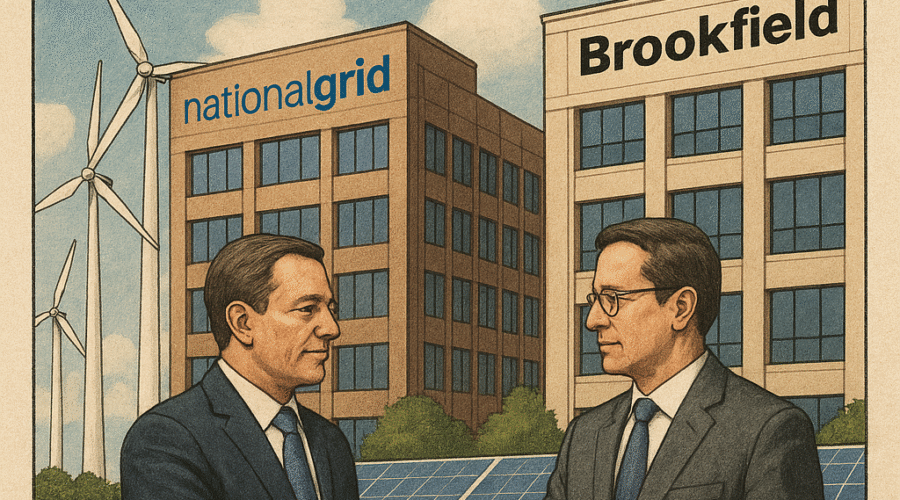In a landmark transaction underscoring shifting priorities in global energy markets, National Grid plc finalized the $1.735 billion sale of its U.S. onshore renewables division to Brookfield Asset Management on May 30, 2025[8][9][11]. The deal transfers 3.1 gigawatts of operational and developing solar, wind, and battery storage assets across 34 U.S. states to Brookfield Renewable Partners, reinforcing the Canadian investor’s position as a dominant force in corporate clean energy procurement while enabling National Grid to accelerate investments in grid modernization[3][13][17]. This transaction occurs against a backdrop of surging electricity demand from artificial intelligence infrastructure and evolving U.S. energy policy under the Trump administration.
💼 Seasoned CorpDev / M&A / PE expertise
Transaction Architecture and Immediate Impacts
Portfolio Composition and Valuation Metrics
The acquired National Grid Renewables portfolio includes 1.8 GW of operational capacity and 1.3 GW in advanced development stages, primarily concentrated in Midwest and Northeast markets[2][4][17]. At $1.735 billion enterprise value, the deal reflects a 15-20% discount to comparable 2024 solar transactions, attributable to political uncertainty surrounding Inflation Reduction Act (IRA) incentives[1][3]. Brookfield secured the assets at an implied $560/kW valuation for operational projects – below the $600-700/kW range seen in Duke Energy’s 2023 solar divestment – suggesting strategic patience in navigating regulatory headwinds[4][18].
Capital Reallocation Strategies
For National Grid, the sale completes a £6.8 billion capital recycling initiative announced in May 2024, with proceeds earmarked for a £60 billion, five-year grid upgrade program across UK and Northeastern U.S. networks[14][15][16]. The utility’s share price gained 23% over the past 12 months, outperforming the FTSE 100 Utilities Index by 9%, as investors rewarded its pivot toward regulated transmission assets[8][11]. Concurrently, Brookfield leverages its $10 billion Global Transition Fund to consolidate fragmented renewable markets, having deployed $12.5 billion in 2024 alone across Neoen, Scout Clean Energy, and now National Grid Renewables[4][12][17].
Strategic Drivers for Buyer and Seller
Brookfield’s Corporate Offtake Playbook
This acquisition strengthens Brookfield’s position as the leading provider of renewable energy to hyperscale data centers, building on its landmark 10.5 GW power purchase agreement (PPA) with Microsoft in 2024[3][17][18]. Jeh Vevaina, Brookfield’s Global CIO for Renewable Power, emphasized that “renewables demand is now corporate-driven rather than policy-dependent,” with tech giants requiring 24/7 clean energy solutions for AI workloads[1][3]. The National Grid portfolio’s geographic overlap with major cloud regions – including 117 MW under construction in Ohio and 100 MW in Wisconsin – provides critical load-matching capabilities[17][18].
National Grid’s Network-Centric Future
By exiting merchant renewables, National Grid CEO John Pettigrew accelerates the “Great Grid Upgrade” – a £54 billion UK transmission overhaul requiring 4,000 miles of new high-voltage lines by 2030[9][14][16]. The company’s U.S. focus shifts to modernizing New York’s Upstate Transmission System and Massachusetts’ gas-electric hybrid networks, where rate base growth projections exceed 10% annually through 2029[15][16]. This strategic clarity helped National Grid secure £7 billion through a 2024 rights issue at 645p/share, with institutional investors comprising 72% of the offering[14][15].
Market Implications and Regulatory Crosscurrents
IRA Policy Uncertainty and Developer Response
Despite President Trump’s freeze on offshore wind permits and proposed IRA amendments, Brookfield remains bullish on onshore renewables due to bipartisan support for grid resilience and private land development[1][3][12]. The administration’s focus on “American energy dominance” has paradoxically increased corporate procurement, with tech firms seeking price stability amid volatile fossil markets[3][18]. However, Bloomberg Intelligence notes that IRA uncertainty pushed 2025 U.S. solar module orders down 22% year-over-year, creating acquisition opportunities for well-capitalized players like Brookfield[1][4].
Valuation Arbitrage in Public vs Private Markets
The transaction highlights growing disparities between public and private renewable valuations. While listed clean energy ETFs traded at 12-15x EBITDA multiples in Q1 2025, Brookfield acquired National Grid Renewables at 9.2x EBITDA – a 30% discount to public comparables[4][12][17]. This gap reflects public market concerns over interest rate sensitivity, contrasting with private equity’s long-term infrastructure outlook. Brookfield’s 2024 investor presentation projects 12-15% IRRs on such acquisitions through 2030, leveraging scale advantages in procurement and tax equity financing[12][17].
Financial Engineering and Synergy Realization
Capital Structure Optimization
Brookfield financed the deal through its $30 billion renewable energy credit facility, achieving 60% debt financing at 5.2% blended interest rate – 150 bps below National Grid’s corporate borrowing costs[4][12][18]. The asset manager plans to securitize 40% of the portfolio’s cash flows through green ABS transactions in 2026, targeting institutional investors seeking inflation-linked returns[6][12]. National Grid, meanwhile, redeployed proceeds into a £2.1 billion HVDC interconnector between Scotland and Yorkshire, projected to deliver 14% regulated ROEs by 2028[14][16].
Operational Synergies and Technology Integration
The acquisition gives Brookfield control of National Grid Renewables’ proprietary energy management system, which uses machine learning to optimize 450 MW of battery storage across Texas and California[6][17]. Early integration plans include deploying Brookfield’s blockchain-based REC tracking platform across the portfolio, enhancing transparency for corporate buyers[12][18]. Cross-selling opportunities emerge with Brookfield’s 69 GW U.S. development pipeline, particularly in co-located solar-storage projects near Microsoft Azure zones[17][18].
Sector Outlook and Strategic Recommendations
Corporate Procurement as Growth Catalyst
With tech companies projected to consume 8% of U.S. electricity by 2030 – up from 3% in 2023 – Brookfield’s focus on behind-the-meter solutions positions it to capture a $50 billion annual corporate PPA market[3][17][18]. The firm’s 2025 investor day outlined plans to dedicate 40% of new capacity to direct corporate contracts, versus 15% in 2024. This shift requires building merchant exposure management capabilities, with Brookfield recently hiring a 12-person energy trading team from Goldman Sachs[12][18].
Regulated Utilities’ Strategic Choices
National Grid’s divestment underscores a broader trend among integrated utilities to shed merchant renewables and focus on rate-based grid investments. Southern Company and Duke Energy have announced similar portfolio reviews, seeking to reallocate $30 billion collectively from volatile renewables to transmission projects with guaranteed returns[12][17]. For regulators, this creates challenges in balancing grid decarbonization goals with utility capital constraints – potentially accelerating state-level community solar mandates to fill the development gap[3][17].
Conclusion: A Bellwether for Energy Transition Finance
The National Grid-Brookfield deal exemplifies sophisticated capital recycling in the energy transition era. For sellers, it demonstrates the value of monetizing mature renewable assets to fund next-generation grid infrastructure. Buyers gain scale advantages in a fragmented market, leveraging corporate demand to offset policy risks. As AI-driven electricity demand grows 8% annually through 2030, such transactions will likely accelerate, with Blackstone and KKR reportedly eyeing similar utility-scale solar portfolios[12][18]. Success in this new paradigm requires balancing technological innovation with financial discipline – a challenge Brookfield and National Grid appear positioned to meet.
Sources
https://financialpost.com/commodities/energy/renewables/brookfield-national-grid-renewables-17-billion, https://irei.com/news/national-grid-to-sell-u-s-renewables-business-to-brookfield-for-1-7b/, https://www.sustainabletimes.co.uk/post/national-grid-sells-u-s-onshore-renewables-portfolio-to-brookfield-in-1-7b-deal, https://www.pv-tech.org/brookfield-to-acquire-national-grid-renewables/, https://pe-insights.com/brookfield-drives-energy-transition-with-1-74bn-acquisition-from-national-grid/, https://www.nationalgridus.com/News/2021/07/National-Grid-Joint-Venture-Secures-150-Million-Portfolio-Revolving-Facility-to-Advance-Multiple-U-S-Renewable-Energy-Projects/, https://www.energyglobal.com/wind/24022025/national-grid-to-sell-us-onshore-renewables-business-to-brookfield-asset-management/, https://www.lse.co.uk/news/in-brief-national-grid-completes-renewables-sale-to-brookfield-ceiurlazoqjnz7x.html, https://www.nationalgrid.com/media-centre/press-releases/completion-of-sale-of-national-grid-renewables, https://www.marketscreener.com/quote/stock/NATIONAL-GRID-PLC-34973324/news/National-Grid-Announces-Completion-Of-Sale-Of-National-Grid-Renewables-50110669/, https://www.morningstar.co.uk/uk/news/AN_1748590305979030800/in-brief-national-grid-completes-renewables-sale-to-brookfield.aspx, https://greentechlead.com/renewable-energy/brookfield-buys-national-grids-renewables-business-for-1-74-bn-49098, https://www.nationalgrid.com/media-centre/press-releases/sale-national-grid-renewables, https://www.directorstalkinterviews.com/national-grid-completes-sale-of-renewables-business-to-brookfield/4121199352, https://www.patronuspartners.com/daily-insights/morning-note-market-news-and-an-update-from-national-grid, https://www.patronuspartners.com/daily-insights/morning-note-market-news-and-an-update-from-national-grid-2, https://pv-magazine-usa.com/2025/02/26/national-grid-divests-u-s-renewables-business-in-1-7-billion-deal/, https://www.connectcre.ca/stories/brookfield-asset-management-to-buy-national-grids-u-s-onshore-biz-for-us-1-7b/





